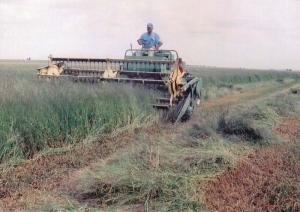2013 - Volume #BFS, Issue #13, Page #104
[ Sample Stories From This Issue | List of All Stories In This Issue | Print this story
]
Demand Grows For Crabgrass Seed
 |
“We sell across the entire country, but the 23 to 25 most South East states are our major market,” says Dalrymple, Elstel Farm & Seeds. “We have a lot of return customers, but there are still a lot of people who haven’t heard of using high production crabgrass for forage.”
Dalrymple’s Red River Crabgrass RRCG and Quick-N-Big are different than the low growing weed you find in your lawn. The forage varieties grow 2 to 4 ft. high, spread by stolons and tillers, and produce seed for volunteer re-establishment.
It’s one of the highest-quality summer grasses, stays green until frost, and can continue to be grazed after frost as a stock pile. In a two year Florida study, the RRCG averaged 15.2 percent protein and 76.8 percent digestibility. Red River Crabgrass seed sold for only $6 to $8 per pound in the spring of 2011; however, seed was a problem in 2012 due to the drought conditions in Oklahoma. 2012 was a much better year and seed for future seasons looks good.
“Our crabgrass fields stayed green longer than other forages, but eventually they turned brown as well,” says Dalrymple.
He notes that his fields had no measureable rain in 7 weeks in 2011 and more than 40 days with temperatures of 100°F or more. The weather bureau reports the area has had the least rain in 115 years.
“It is mind boggling to me, even though I have worked with crab grasses since 1972,” says Dalrymple. “The Quick-N-Big still grew knee high and was enough to swath for some seed and bale for hay.”
In a good year, he says, the crop can yield up to 6 tons of dry matter per acre under intensive management. More usual returns are closer to two to three tons of dry matter per acre in a pure stand, which is a lot of high quality grass.
“It can be seeded to a pure stand at a rate of 3 to 6 lbs./acre or used in a mix of summer forages,” he says. “It can also be double cropped with winter legumes and annual grasses.”
Contact: FARM SHOW Followup, Elstel Farm and Seeds, 2640 Springdale Rd., Ardmore, Okla. 73401 (ph 580 670-0043 rlandpat@cableone.net; www.redrivercrabgrass.com).

Click here to download page story appeared in.
To read the rest of this story, download this issue below or click here to register with your account number.




